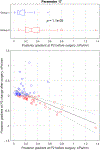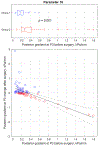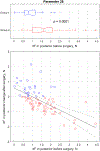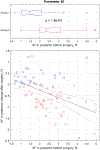Predictive Value of Biomechanical Mapping for Pelvic Organ Prolapse Surgery
- PMID: 31625957
- PMCID: PMC7737515
- DOI: 10.1097/SPV.0000000000000786
Predictive Value of Biomechanical Mapping for Pelvic Organ Prolapse Surgery
Abstract
Objective: This study examined biomechanical changes in pelvic floor after urogynecological surgery.
Methods: This multisite clinical study was designed to explore changes in tissue elasticity, pelvic support, and certain functions (contractive strength, muscle relaxation speed, muscle motility) after pelvic organ prolapse (POP) surgery. A biomechanical mapping of the pelvic floor was performed before and 4 to 6 months after the surgery. The biomechanical data for 52 parameters were acquired by vaginal tactile imaging for manually applied deflection pressures to vaginal walls and pelvic muscle contractions. The two-sample t-test (P < 0.05) was used to test the null hypothesis that presurgery data in group 1 (positive parameter change after surgery) and presurgery data in group 2 (negative parameter change after surgery) belonged to the same distribution.
Results: A total of 78 subjects with 255 surgical procedures were analyzed across 5 participating clinical sites. All 52 t-tests for group 1 versus group 2 had P value in the range from 4.0 × 10-10 to 4.3 × 10-2 associating all of the 52 parameter changes after surgery with the presurgical conditions. The P value of before and after surgery correlation ranged from 3.7 × 10-18 to 1.6 × 10-2 for 50 of 52 tests, with Pearson correlation coefficient ranging from -0.79 to -0.27. Thus, vaginal tactile imaging parameters strongly correlated weak pelvic floor presurgery with the positive POP surgery outcome of improved biomechanical properties.
Conclusions: Pelvic organ prolapse surgery, in general, improves the biomechanical conditions and integrity of the weak pelvic floor. The proposed biomechanical parameters can predict changes resulting from POP surgery.
Copyright © 2019 American Urogynecologic Society. All rights reserved.
Conflict of interest statement
Vladimir Egorov is a co-founder and a CEO of Advanced Tactile Imaging; Peter Takacs, S. Abbas Shobeiri, Lennox Hoyte, and Vincent Lucente have no conflicts of interest; Heather van Raalte is a minor shareholder in Advanced Tactile Imaging; and Noune Sarvazyan is a major shareholder in Artann Laboratories.
Figures








References
-
- Jeffery S, Roovers JP, Quo Vadis. Vaginal Mesh in Pelvic Organ Prolapse? Int Urogynecol J. 2018;29(8):1073–1074. - PubMed
-
- Jelovsek JE, Barber MD, Brubaker L, et al. NICHD Pelvic Floor Disorders Network. Effect of Uterosacral Ligament Suspension vs Sacrospinous Ligament Fixation With or Without Perioperative Behavioral Therapy for Pelvic Organ Vaginal Prolapse on Surgical Outcomes and Prolapse Symptoms at 5 Years in the OPTIMAL Randomized Clinical Trial. JAMA 2018;319(15):1554–1565. - PMC - PubMed
Publication types
MeSH terms
Grants and funding
LinkOut - more resources
Full Text Sources
Other Literature Sources

